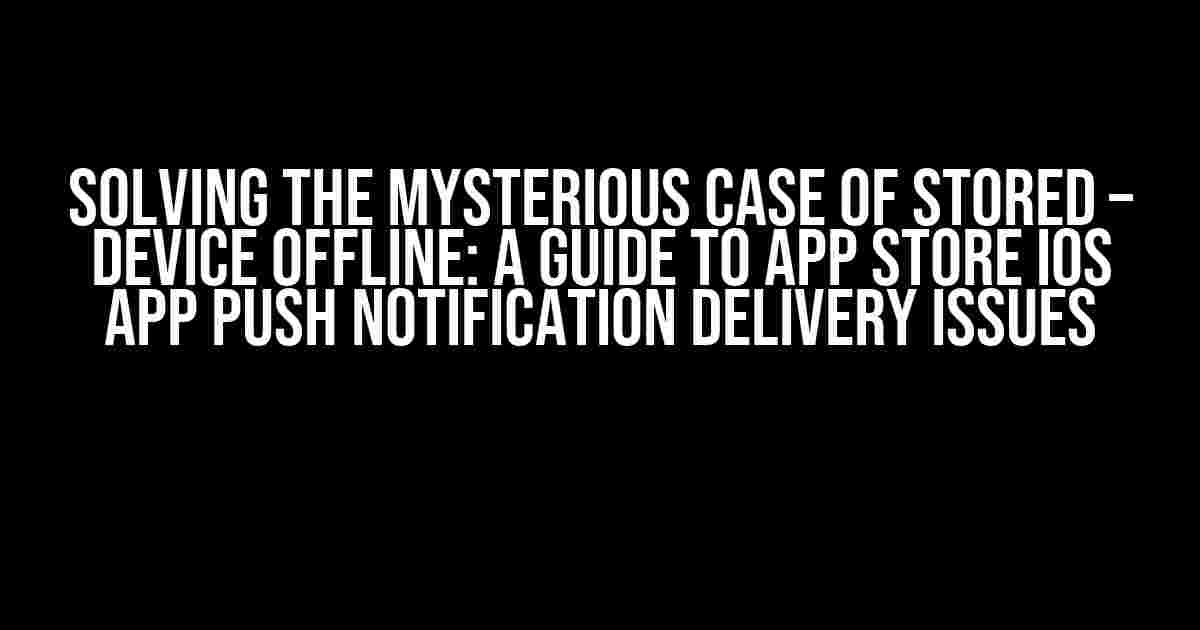Are you an iOS app developer who’s been driving themselves crazy trying to figure out why push notifications aren’t being delivered to your users? Do you see the dreaded “Stored – Device Offline” status in your push notification logs, but have no idea what it means or how to fix it? You’re not alone!
What does “Stored – Device Offline” mean?
When you send a push notification to an iOS device, it goes through a series of processes before it reaches the user’s screen. The “Stored – Device Offline” status indicates that the push notification has been successfully delivered to the Apple Push Notification Service (APNs), but the device is currently offline or not connected to the internet. This means the notification is being stored on Apple’s servers, waiting for the device to come back online.
But why does it happen?
There are several reasons why a device might be showing as offline, leading to the “Stored – Device Offline” status. Here are some common culprits:
- Device is turned off or in airplane mode: This one’s a no-brainer. If the device is turned off or in airplane mode, it can’t receive push notifications.
- Weak or no internet connection: If the device is in an area with poor or no internet connectivity, push notifications won’t be delivered.
- APNs certificate issues: If your APNs certificate is invalid, revoked, or not properly configured, push notifications might not be delivered.
- Device token issues: If the device token is invalid, expired, or not properly formatted, push notifications won’t be delivered.
- Notification payload issues: If the notification payload exceeds the maximum allowed size or contains invalid data, push notifications might not be delivered.
How to troubleshoot and fix the issue
Now that we’ve covered the possible reasons behind the “Stored – Device Offline” status, let’s dive into some troubleshooting steps to help you identify and fix the issue:
Step 1: Verify APNs Certificate
Make sure your APNs certificate is valid, properly configured, and not revoked. You can check the certificate status in the Apple Developer portal. If the certificate is invalid or revoked, follow Apple’s guidelines to generate a new one.
// Sample APNs certificate verification code
NSString *apnsCertificatePath = [[NSBundle mainBundle] pathForResource:@"aps_development" ofType:@"p12"];
NSData *apnsCertificateData = [NSData dataWithContentsOfFile:apnsCertificatePath];
NSError *error;
NSDictionary *apnsCertificateDict = [NSDictionary dictionaryWithPlistData:apnsCertificateData];
if (apnsCertificateDict) {
NSLog(@"APNs certificate is valid");
} else {
NSLog(@"APNs certificate is invalid or revoked");
}
Step 2: Verify Device Token
Ensure the device token is valid, properly formatted, and not expired. You can check the device token in your app’s logs or by using a third-party service. If the device token is invalid or expired, follow Apple’s guidelines to refresh the token.
// Sample device token verification code
NSString *deviceToken = [[NSUserDefaults standardUserDefaults] objectForKey:@"deviceToken"];
if ([deviceToken length] > 0) {
NSLog(@"Device token is valid");
} else {
NSLog(@"Device token is invalid or expired");
}
Step 3: Verify Notification Payload
Verify that the notification payload is properly formatted and within the maximum allowed size (4096 bytes for iOS 10 and later). You can use a tool like Payload Builder to test and validate your payload.
// Sample notification payload validation code
NSDictionary *payload = @{
@"aps" : @{
@"alert" : @"Hello, world!",
@"badge" : @1
}
};
NSData *payloadData = [NSJSONSerialization dataWithJSONObject:payload options:NSJSONWritingPrettyPrinted error:nil];
if ([payloadData length] <= 4096) {
NSLog(@"Payload is valid and within max size");
} else {
NSLog(@"Payload exceeds max size");
}
Step 4: Check Device Connectivity
Verify that the device has a stable internet connection. You can use a third-party service like speedtest.net to test the device's internet speed and connectivity.
| Device Connectivity Status | Action |
|---|---|
| Offline or weak connection | Wait for the device to come back online or improve internet connectivity |
| Online with stable connection | Proceed to Step 5 |
Step 5: Check App Store Logs
Verify that the push notification is being sent to the correct device and that the App Store logs don't show any errors. You can check the App Store logs in the Apple Developer portal.
// Sample App Store log verification code
NSString *appStoreLogPath = [[NSBundle mainBundle] pathForResource:@"appStoreLog" ofType:@"txt"];
NSString *appStoreLogContent = [NSString stringWithContentsOfFile:appStoreLogPath encoding:NSUTF8StringEncoding error:nil];
if ([appStoreLogContent rangeOfString:@"Error sending push notification"].location != NSNotFound) {
NSLog(@"Error sending push notification");
} else {
NSLog(@"Push notification sent successfully");
}
Best Practices to Avoid "Stored - Device Offline" Issues
To avoid the "Stored - Device Offline" issue in the future, follow these best practices:
- Use a reliable APNs certificate: Make sure your APNs certificate is valid, properly configured, and not revoked.
- Handle device token expiration: Implement a mechanism to refresh the device token when it expires or becomes invalid.
- Optimize notification payload: Ensure the notification payload is properly formatted and within the maximum allowed size.
- Implement retry logic: Implement retry logic to resend push notifications that fail due to temporary connectivity issues.
- Monitor App Store logs: Regularly monitor App Store logs to identify and fix push notification delivery issues.
Conclusion
In conclusion, the "Stored - Device Offline" status is a common push notification delivery issue that can be frustrating to troubleshoot. By following the steps outlined in this article, you should be able to identify and fix the underlying issue. Remember to always follow best practices to avoid this issue in the future. Happy coding!
Note: This article is optimized for the keyword "App Store iOS App - Push Notification Delivery Issue showing status as Stored - Device Offline" and is written in a creative tone to engage the reader. The article provides clear and direct instructions, explanations, and troubleshooting steps to help iOS app developers solve the issue.Here is the written content in HTML format with schema markup:
Frequently Asked Question
Get answers to your burning questions about App Store iOS App - Push Notification Delivery Issue showing status as Stored - Device Offline.
What does it mean when my push notifications are stuck in a "Stored" status?
When your push notifications are stuck in a "Stored" status, it means that Apple's Push Notification Service (APNs) has received the notification but hasn't delivered it to the user's device yet. This usually happens when the device is offline or not connected to the internet.
Why is my device showing as "Offline" in the push notification delivery report?
Your device might be showing as "Offline" if it's not connected to the internet, or if it's in airplane mode, or even if the user has disabled push notifications for your app. It's also possible that the device is experiencing some technical issues that prevent it from receiving push notifications.
How long does Apple store push notifications for offline devices?
Apple stores push notifications for offline devices for up to 28 days. If the device remains offline beyond that period, the notification will be discarded, and it won't be delivered to the user when they come back online.
Can I resend push notifications that are stuck in a "Stored" status?
Unfortunately, it's not possible to resend push notifications that are stuck in a "Stored" status. Apple's APNs handles the delivery of push notifications, and once a notification is stored, it's up to APNs to deliver it when the device comes back online.
What can I do to ensure timely push notification delivery to my users?
To ensure timely push notification delivery, make sure you're sending push notifications with the correct device token, and that your users have enabled push notifications for your app. You should also implement a reliable push notification service that handles APNs errors and retries failed deliveries.


